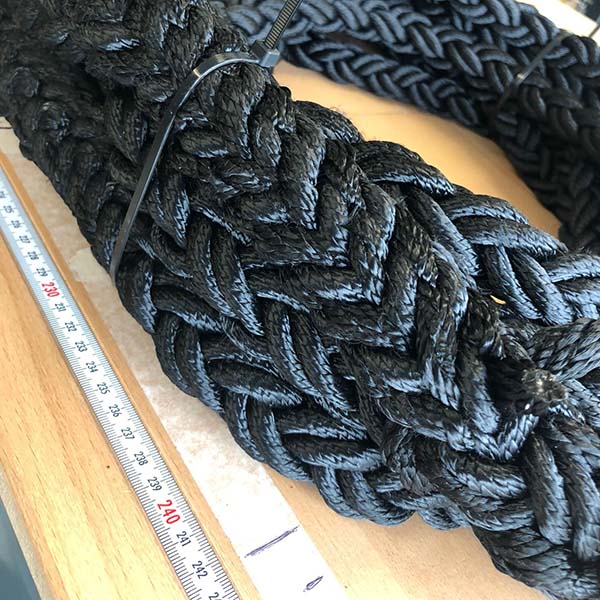Recommended Installers
Premium Ropes
How strong should a towing line be?
Premiumropes makes calculations to determine the ideal towing line strength, provided we receive specific information such as the tender’s water displacement, waterline length, towing speed, yacht tonnage, yacht length, and towing eye strength.
“TowPro makes the ideal combination and also the ability to use lighter tow ropes to avoid damage to the tenders”.
Jeroen Baggerman
PREMIUMROPES / LIJNENSPECIALIST
Surinamekade 6, 1019 BV Amsterdam, Netherlands
Info@preiumropes.com
+31 20 419 6412
Which material is used for towing lines?
Premiumropes exclusively manufactures towing lines using high-quality materials tailored to each part’s application, or as per the captain’s or yard’s requirements.
Towing bridle
It’s advisable to construct the primary bridle from sturdy, buoyant material. The line should also have elongation and clear in the water. For these qualities, we employ our PR-12 Rope. On request this part can also be made from a 8- or 12-strand polyester (non-floating).
Towline
It’s important to have a reliable towline, necessitating strength, wear resistance, buoyancy, and high visibility. We craft our towlines from industrial grade DX Core Dyneema Rope, featuring a specially designed durable coating for added UV and abrasion resistance.
Tender bridle
The tender bridle often utilizes the same material as the towline. Sometimes we use a thinner diameter for the bridle. The choice depends on whether towing occurs at one, two, or three points.
TSM-Systems Customer support contact details:
Email: tech.support@tsm-systems.com
Customer FAQ's
- TowPro provides continuous status information from the tender to the yacht via the VHF ‘Data Exchange System’ spectrum.
- This information is displayed on a colour touch screen display on the bridge to allow the crew to monitor the status of the tow.
- The status information alert levels are set by you ensuring that you can define the criteria and override the default settings
- The tiled display enables you to also define which alerts you deem most important to be displayed on the front screen. a swipe to the right takes you to the next page ensuring you have easy access to all the impotant tow information
- TowPro geofences the yacht and tender setting off an audible and visual alarm if the tender goes outside the user defined range.
- In the event of the tow being lost TowPro 1) alerts the bridge, 2) switches on the AIS broadcast, 3) activates the COLREG lights and 4) activates transmission to the emergency tracking service.
TowPro is built to be easy to install by a ship’s engineer, or alternatively you can use a local trusted installer. Please see our list of recommended installers. If you are still struggling to find either of these, please contact us and we may be able to help you find one local to you.
Yes, TowPro provides relay coupled outputs for alarms and warnings, with separate outputs for “alarm triggered” and “alarm triggered and not muted”
Yes, TowPro provides a graphical interface which displays tow distance and allows you to set the distance interactively.
TowPro will give you a continuous display of tender battery voltage, so that you can monitor this whilst towing. If it gets low, you can act to manage the situation. TowPro has a 7-day backup battery in the AIX-AIS and Iridium units, so the tender location can continue to be tracked.
TowPro is available with “multi-tender” options. Please contact TSM Systems for details.
It is your choice. The TowPro display on the tender only requires you to input system settings. It has IP67 protection and daylight viewability so can be mounted outside, or can be installed e.g. inside the console with a simple power off-on switch.
TowPro is designed to ensure that there are no hidden costs. The emergency tracking website is available as a fixed 3-year contract including Iridium airtime.
Simple, press “get a quote” and we will contact you alternatively – pick up the phone. We supply TowPro globally.
We can ship globally and will include the cost of shipping on all quotes. Note all quotes are provided ex works from the UK.
Installer FAQ's
The yacht installation requires 12/24VDC protected at 2Amps.
The tender installation requires 12/24VDC protected at 2Amps.
TowPro outputs AIVDM messages on NMEA0183 at 38,400 baud rate (requires opto-isolation at the yacht)
TowPro activates an ‘open collector’ output which should be used to operate a decoupling relay, the contacts of the relay provide a switch input to the alarm management system.
This is a CANbus connection running on NMEA2000 cabling. An N2K backbone is required dedicated to this connection: the drop cables [supplied] connect the 2 units to the backbone, and the TowPro power supply should be provided via the backbone.
TowPro requires connection to a VHF antenna. This can either be direct to a dedicated antenna, or via an antenna splitter/switch to an existing antenna.
TowPro on the tender requires connection to 1) a VHF antenna, 2) a GNSS antenna, 3) an Iridium antenna [note that these are normally integrated in a single antenna].
The level switches in Bilge 1 and Bilge 2 should be Normally Open contacts connected to 0VDC.
The bilge pump run sense wires for Bilge Pump 1 and Bilge Pump 2 are ‘active high’ and should be at 12VDC when that pump is running.
The TowPro interface is built on a Maretron CMLD12 unit, configured to provide two parallel switched Emergency Light outputs each rated at 5Amps. The power supply for these lights is separate from the TowPro power supply.
This is a CANbus connection running on NMEA2000 cabling. An N2K backbone is required dedicated to this connection: the drop cables [supplied] connect the 2 units to the backbone, and the TowPro power supply should be provided via the backbone.
This is a N2K connection running on NMEA2000 cabling. An N2K backbone is required dedicated to this connection: the drop cables [supplied] connect the 2 units to the backbone, and the TowPro power supply should be provided via the backbone.

